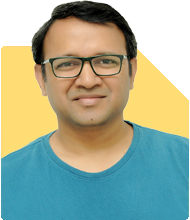39-Year-Old Investor Seeks Advice: Can Portfolio Achieve 5 Crore Goal in 7 Years?
Ramalingam Kalirajan |10208 Answers |Ask -Follow
Mutual Funds, Financial Planning Expert - Answered on Dec 11, 2024
He has an MBA in finance from the University of Madras and is a certified financial planner.
He is the director and chief financial planner at Holistic Investment, a Chennai-based firm that offers financial planning and wealth management advice.... more

Hello Sir , I am 39 years old my mutual fund portfolio is 42.02 Lakh as of today doing SIP in Canara Robecoo Blue chip- 5000, HDFC focused 30 -10000, HDFC midcap opportunities-10000, ICICI pruden. Nifty 200 Momentum -10000, Parag Parekh Flexi Cap -10000, SBI contra -10000, SBI Nifty index fund -10000, Tata Small Cap -10000, Moti Lal Oswal Nasdaq 100 - 10000, In total of 85000 Per month with planning to increase 10% every year , I am looking for a horizon of another 7 years to accumulate a corpus of 5 crores / Please guide me if the investment and planning can meet the desired goal or else how much i an expect it to reach ? Any suggestion to add/remove any funds? Any changes required in my investment approach
You are investing Rs. 85,000 monthly, which is a significant commitment.
Your SIPs are diversified across categories, including large-cap, mid-cap, and flexi-cap funds.
You have exposure to momentum, thematic, and international funds.
Your plan to increase SIPs by 10% yearly is a positive step.
Assessing Your Corpus Target
Your goal is to accumulate Rs. 5 crores in 7 years.
Equity investments over 7 years may yield good returns due to compounding.
However, achieving Rs. 5 crores depends on consistent returns and SIP increases.
Market fluctuations can impact growth, requiring regular monitoring.
Insights on Fund Allocation
Your portfolio has multiple schemes, which might cause over-diversification.
Too many funds may reduce focus and overlap stock holdings.
Avoid index funds for higher returns. Actively managed funds often outperform.
Direct funds lack personalized advice. Regular plans with Certified Financial Planners add value.
Ensure all funds align with your risk profile and long-term goals.
Suggested Portfolio Changes
Reduce overlapping categories. Focus on fewer, well-performing funds.
Replace underperforming funds with actively managed funds.
Avoid investing in too many thematic or sector-specific funds.
Increase allocation to mid-cap and flexi-cap funds for higher growth potential.
Review international exposure. It should be limited to 10-15% of your portfolio.
Enhancing Investment Strategy
Stick to equity funds for long-term wealth creation.
Avoid debt funds unless needed for short-term goals or stability.
Rebalance your portfolio yearly to align with your goals.
Include funds with consistent performance across market cycles.
Monitor taxation. Plan redemptions to optimise tax impact.
The Disadvantages of Index Funds
Index funds track the market passively.
They cannot outperform the market or take advantage of opportunities.
Actively managed funds are better for high returns over the long term.
Index funds lack professional intervention during volatile phases.
Importance of Regular Plans
Regular plans provide expert guidance from Certified Financial Planners.
Direct funds may seem cost-effective but lack personalised insights.
Regular plans ensure disciplined investing and strategic reviews.
Setting Up a Review Plan
Review your portfolio performance annually.
Assess returns, diversification, and risk-adjusted performance.
Make adjustments based on market conditions and personal financial changes.
Tax Considerations for Mutual Funds
Equity mutual funds have new tax rules.
LTCG above Rs. 1.25 lakh is taxed at 12.5%.
STCG is taxed at 20%.
Plan withdrawals to minimise tax impact.
Final Insights
Your goal is achievable with disciplined investing and portfolio optimisation.
Avoid over-diversification and focus on fewer, high-performing funds.
Stay committed to SIP increases to accelerate corpus growth.
Consult a Certified Financial Planner for annual reviews and strategic adjustments.
A focused and well-managed portfolio will help you achieve your financial goals.
Best Regards,
K. Ramalingam, MBA, CFP,
Chief Financial Planner,
www.holisticinvestment.in
https://www.youtube.com/@HolisticInvestment
You may like to see similar questions and answers below
Hemant Bokil | Answer |Ask -Follow
Financial Planner - Answered on Mar 21, 2023
Ramalingam Kalirajan |10208 Answers |Ask -Follow
Mutual Funds, Financial Planning Expert - Answered on May 30, 2024
Ramalingam Kalirajan |10208 Answers |Ask -Follow
Mutual Funds, Financial Planning Expert - Answered on Aug 12, 2024
Ramalingam Kalirajan |10208 Answers |Ask -Follow
Mutual Funds, Financial Planning Expert - Answered on Nov 26, 2024
Nayagam P P |10149 Answers |Ask -Follow
Career Counsellor - Answered on Aug 11, 2025
Nayagam P P |10149 Answers |Ask -Follow
Career Counsellor - Answered on Aug 11, 2025
Nayagam P P |10149 Answers |Ask -Follow
Career Counsellor - Answered on Aug 11, 2025
Nayagam P P |10149 Answers |Ask -Follow
Career Counsellor - Answered on Aug 11, 2025
Nayagam P P |10149 Answers |Ask -Follow
Career Counsellor - Answered on Aug 11, 2025
Patrick Dsouza |1365 Answers |Ask -Follow
CAT, XAT, CMAT, CET Expert - Answered on Aug 11, 2025
Nayagam P P |10149 Answers |Ask -Follow
Career Counsellor - Answered on Aug 11, 2025
Nayagam P P |10149 Answers |Ask -Follow
Career Counsellor - Answered on Aug 11, 2025
Nayagam P P |10149 Answers |Ask -Follow
Career Counsellor - Answered on Aug 11, 2025
Nayagam P P |10149 Answers |Ask -Follow
Career Counsellor - Answered on Aug 11, 2025



















